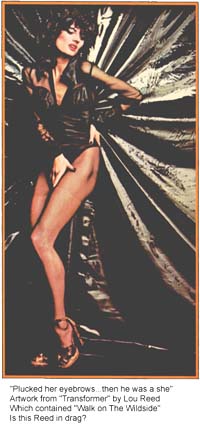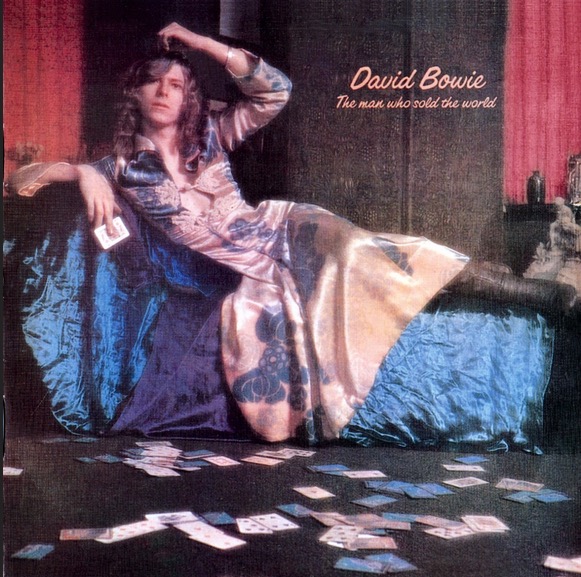Transgender Rock: The 1970s, David Bowie and Glam Rock
By Aleisha Michelle Emerson
“Plucked her eyebrows on the way,
Shaved her legs and then He was a She”— Lou Reed, “Walk On The Wild Side”
While The Beatles, The Kinks, The Who and other bands were blurring the lines of gender in music a young man by the name of David Robert Jones was beginning his own career, one which would change forever the ways in which gender in Rock would be perceived. In 1967 he changed his name to avoid confusion with Davy Jones of the Monkees. . . the first of many chameleon-like changes his image and music would go through. The name he selected is now synonymous with an androgynous or ‘gender-bending’ approach to music. His name. . . David Bowie.
Bowie’s career did not begin with a particularly transgendered image, in fact his early work and look was indistinguishable from the hordes of young men in Britain in the 1960s who were desperately trying to be Pop stars in America. As David Robert Jones he worked with bands with names such as “The Lower Third,” “The Mannish Boys,” or “The King Bees.” Even upon changing his name 1967, his style and image had changed only slightly to that of coffeehouse folk singer. His career was moving along in relative obscurity until 1969, when he scored a hit single with Space Oddity. The song was timed perfectly with the U.S. moon landing and brought him a measure of fame, but once the single left the charts so did the name ‘Bowie’ from the minds of many. He appeared to be yet another of a string of one-hit wonders who had had a brief dalliance with fame.
In 1970 he began a career path that was to ensure no one would forget the name ‘Bowie’ again. His 1970 release, The Man Who Sold The World, contained no hit singles, but gained much attention from the press and public for something else. . . the album cover. The photo on the cover shows a somewhat androgynous Bowie reclining on a couch. . . in a dress. The British music press was quick to pick up this ‘event’ as a story, and in many ways it overshadowed anything actually on the record itself.
Bowie appeared for photo shoots wearing the ‘Man Dress,’ which had been designed by his friend, an avant-garde Italian designer by the name of Freddi Buretti. The controversy, while not great, was enough to prompt David’s American label, RCA, to refuse the ‘Man Dress’ cover. In the U.S. the album was released with a less than controversial cartoon cover, and later a black and white photo of David playing the guitar (The ‘Man Dress’ cover finally did make it to America, albeit 20 years late, when The Man Who Sold The World was rereleased on compact disc in the 1990s). Bowie’s name was beginning to become one that few in the music industry would forget.
After the release of the relatively inauspicious Hunky Dory in 1971, Bowie set about creating his most famous persona — Ziggy Stardust. His The Rise And Fall Of Ziggy Stardust And The Spiders From Mars album, released in 1972, set the stage for his new image. Ziggy was an androgynous star, loved equally by women and men. The song Lady Stardust highlighted this image: “Femme fatales emerged from shadows to watch this creature fair / Boys stood upon their chairs to make their point of view.” With the release of the album in 1972 Bowie went from a ‘fringe’ performer in Britain to one whose name was instantly recognizable on both sides of the Atlantic.
Bowie’s live show further developed the androgyny. He would appear dressed in outrageous costumes, wearing feather boas and prancing and preening on stage. He wore extravagant makeup (in the ‘rockumentary’ film on Ziggy he jokingly tells his then wife Angela “What do you know about makeup, you’re only a girl?”), and finely honed his entire appearance into one which stressed neither masculine or feminine. Riding the success of Ziggy he released three more albums in which he further expanded upon his image, Aladdin Sane and Pin Ups in 1973, and Diamond Dogs in 1974. Ever conscious of his image, and fearful of the character becoming bigger than his own career, Bowie left the Ziggy persona behind in 1975 for a much tamer image. His career was not finished with transgenderism, however, just merely on hold.
Bowie’s success with this new “Glam Rock” image inspired many. . . from established artists such as the Rolling Stones (who admittedly had played with gender lines before, most notably the cover for their 1966 single Have You Seen Your Mother, Baby, Standing in the Shadow? for which the entire band was dressed in drag), and emerging performers such as Lou Reed, Roxy Music, Gary Glitter, Mott the Hoople, and T. Rex. The standard for male Rock performers seemed to be lip gloss and eye shadow. . . the more outrageous a performer’s image the better. Song content began to cross gender lines more frequently too.
Reed’s Walk On The Wild Side had a transgendered heroine, whose transition from he to she occurred on a cross-country trip. And Mott the Hoople scored a hit with the Bowie-penned Gay/Drag anthem All The Young Dudes. There were many flops, too, such as Jobriath. . . a shameless adaption of Bowie’s Ziggy character who, despite Capitol records pouring countless dollars into promotion, disappeared after two forgettable albums in 1973. All of the lip gloss and eyeshadow in the world couldn’t rescue his career.
By the late 1970s the Glam rock movement had stalled, and artists were either finding new images for themselves or disappearing. Bowie himself had disappeared into Berlin to work on brooding synthesizer music with Brian Eno. Transgenderism in Rock music seemed all but dead as the decade was closing. Punk Rock had become the newest fad, and though many Punk performers dressed quite extravagantly, the image seemed more intended to shock on a sociological/political level than on a gender level.
Transgenderism in Rock music was far from dead, however. It seems fitting, too, that Bowie would be the artist to breathe life back into it, using the new medium of the Music Video. The video for his 1979 single Boys Keep Swinging featured Bowie in full drag, in a 1950s style full skirt, and in a gold lame evening gown, looking very much the ‘femme fatale.’
As the 1980s began the Music Video would have a profound influence on the way Music was perceived, experienced, and marketed. Transgendered performers, with their flair for visuals, made great use of this new medium. . . and many artists who were influenced by Bowie would go on to make their own careers.
Next: The 1980s, 1990s, and Beyond. . .
Like to make a comment? Login here and use the comment area below.
Category: All TGForum Posts, Transgender Fun & Entertainment, Transgender History













